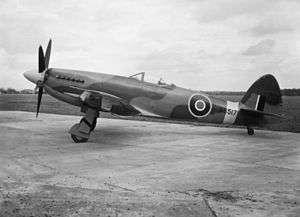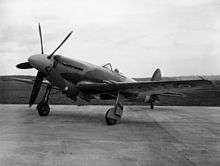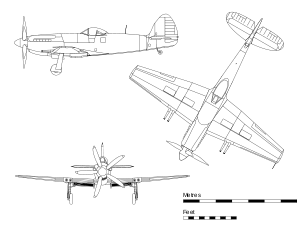Supermarine Spiteful
The Supermarine Spiteful was a British Rolls-Royce Griffon-engined fighter aircraft designed by Supermarine to Air Ministry specification F.1/43 during the Second World War as a successor to the Spitfire. It had a new wing design, to improve its critical Mach number and allow safe operations at higher speeds. The new design also had a modern inwards-retracting undercarriage. Other changes included a larger fin to improve the somewhat marginal stability of Griffon Spitfires and changes to the mounting of the engine to tilt it down slightly for better visibility over the nose.
| Spiteful | |
|---|---|
 | |
| Supermarine Spiteful FXIV, RB517 | |
| Role | Fighter |
| Manufacturer | Supermarine |
| Designer | Joe Smith |
| First flight | 30 June 1944 |
| Status | Out of service |
| Primary user | Royal Air Force |
| Number built | 19 (2 prototypes and 17 production) |
| Developed from | Supermarine Spitfire |
| Variants | Supermarine Seafang Supermarine Attacker |
The Spiteful was ready for production as the war was ending and was passed over in favour of jet-powered designs. The Royal Navy continued development as the Supermarine Seafang as it was not clear jets could safely operate from aircraft carriers but the success of the de Havilland Sea Vampire led to this project being cancelled in 1945. Discussions with the French firm SNCAC to produce the Spiteful under licence were abandoned when France produced jet engines. Of the original order for 150 Spitefuls, only a small number were completed.
Design and development
By 1942, Supermarine designers had realised that the characteristics of the Spitfire's wing at high Mach numbers might become a limiting factor in increasing the aircraft's high-speed performance. The main problem was the aeroelasticity of the Spitfire's wing; at high speeds the relatively light structure behind the strong leading edge torsion box would flex, changing the airflow and limiting the maximum safe diving speed to 480 mph (772 km/h) IAS.[nb 1] If the Spitfire were to be able to fly higher and faster, a radically new wing would be needed.[1]
Joseph Smith and the design team were aware of a paper on compressibility, published by A.D. Young of the R.A.E, in which he described a new type of wing section; the maximum thickness and camber would be much nearer to the mid-chord than conventional airfoils and the nose section of this airfoil would be close to an ellipse.[nb 2] In November 1942, Supermarine issued Specification No 470 which (in part) stated:
A new wing has been designed for the Spitfire with the following objects: 1) To raise as much as possible the critical speed at which drag increases, due to compressibility, become serious. 2) To obtain a rate of roll faster than any existing fighter. 3) To reduce wing profile drag and thereby improve performance. The wing area has been reduced from 242 sq ft (22.5 m2) to 210 sq ft (20 m2) and a thickness chord ratio of 13% has been used over the inner wing where the equipment is stored. Outboard the wing tapers to 8% thickness/chord at the tip.[1]
Specification 470 described how the wing had been designed with a straight taper to simplify production and to achieve a smooth and accurate contour. The wing skins were to be relatively thick, aiding torsional rigidity which was needed for good aileron control at high speeds. Although the prototype was to have a dihedral of 3° it was intended that this would be increased in subsequent aircraft.[1] To improve the ground-handling the Spitfire's narrow-track, outward-retracting undercarriage was replaced with a wider-track, inward-retracting system. (This eliminated a weakness in the original Spitfire design, giving the new plane similar, safer landing characteristics, comparable to the Hurricane, Typhoon, Tempest, Mustang, and Focke-Wulf 190.) The Air Ministry was impressed by the proposal and, in February 1943, issued Specification F.1/43 for a single-seat fighter with a laminar flow wing; there was also to be provision made for a wing folding scheme to meet possible Fleet Air Arm requirements. The new fighter was to use a fuselage based on a Spitfire VIII.[2]
The new wing was fitted to a modified Spitfire XIV NN660, in order to make a direct comparison with the earlier elliptical wing, and was first flown on 30 June 1944 by Jeffrey Quill. Although the new Spitfire's speed performance was comfortably in excess of an unmodified Spitfire XIV, the new wing displayed some undesirable behaviour at the stall which, although acceptable, did not come up to the high standards of Mitchell's earlier elliptical wing. NN660 crashed on 13 September 1944 while performing mock-combat at low altitude with a standard Spitfire, killing pilot Frank Furlong. No reason for the loss was officially established,[3] although Quill suspected that the aileron control rods had momentarily seized, the Spiteful using control rods rather than the Spitfire's cables. Quill noted that from then on a careful check was always made of the control rods at the factory, and that type of accident never re-occurred.
In the meantime, the opportunity had been taken to redesign the Spitfire's fuselage, to improve the pilot's view over the nose and to eliminate gross directional instability by using a larger fin and rudder. This instability had been apparent since the introduction of the more powerful Griffon engine. The instability was exacerbated by the increase in propeller blade area due to the introduction of the four-bladed and subsequent five-bladed Rotol airscrews for the next aircraft, NN664 (for which Specification F.1/43 had been issued). The updated design incorporated the new fuselage (although lacking the enlarged fin/rudder) and, as it was now substantially different from a Spitfire, the aircraft was named "Spiteful" (although "Victor" had been originally proposed).
Operational history

The Spiteful was ordered into production as the Spiteful XIV (having no preceding marks of its own, the numerals were carried over from the original Spitfire XIV conversion), and 150 of the aircraft were ordered. With the advent of jet propulsion, however, the future of high-performance fighters was clearly with the jet-engined aircraft, and so the order was later cancelled with only a handful of Spitefuls built. At the time however, there was some uncertainty over whether jet aircraft would be able to operate from the Royal Navy's aircraft carriers so it was decided to develop a naval version of the Spiteful, to specification N.5/45,[4] subsequently named Seafang.
The Seafang featured folding wingtips, a "sting"-type arrester hook and a Griffon 89 or 90 engine, fed from an extended carburettor air intake driving two new Rotol three-bladed contra-rotating propellers. The first one produced was a converted Spiteful XV (RB520) but with the successful operation of the de Havilland Sea Vampire from the carrier HMS Ocean in 1945, the need for the Seafang disappeared.
With the end of the Second World War, Supermarine entered into discussions with Société Nationale de Constructions Aéronautiques du Nord (SNCAN) about licence production of the Spiteful in France, but again the introduction of jet fighters overshadowed the piston-engined fighter and the talks came to nothing.
Variants
- Spiteful F Mk 14 - 19 built (two prototypes and 17 production)
- Engine: Griffon 69 - 2,375 hp (1,771 kW)
- Weight: 9,950 lb (4,513 kg)
- Max Speed: 483 mph (777 km/h)
- Spiteful F Mk 15 - one built - converted to Seafang prototype
- Engine: Griffon 89 - 2,350 hp (1,752 kW)
- Weight: 10,200 lb (4,627 kg)
- Max Speed: 476 mph (766 km/h)
- Spiteful F Mk 16 - two built - simple, three-speed Griffon conversions from F Mk 14s
- Engine: Griffon 101 - 2,420 hp (1,805 kW)
- Weight: 9,950 lb (4,513 kg)
- Max Speed: 494 mph (795 km/h) at 28,500 ft, 408 mph (656 km/h) at sea level[5]
- Seafang F.Mk 31 - eight built
- Engine: Griffon 61
- Seafang F.Mk 32 - ten built
- Engine: Griffon 89 - 2,350 hp (1,752 kW)
Jet Spiteful
In late 1943 or early 1944, Supermarine's chief designer Joe Smith suggested Supermarine develop a simple jet fighter based around the Spiteful's wing, and use a new jet engine being proposed by Rolls-Royce (later the Nene). This proposal was accepted and a new specification, E.10/44, was issued by the Air Ministry for an experimental aircraft which was initially referred to as the Jet Spiteful; the prototype TS409 first flew on 27 July 1946. The E.10/44 was not ordered by the RAF, as its performance was not substantially better than the Gloster Meteor and de Havilland Vampire, but the Admiralty expressed an interest in the aircraft for use as a naval fighter and issued specification E.1/45 around it. The aircraft was subsequently named Attacker and had a short career with the Fleet Air Arm and the Pakistan Air Force.
Spiteful tail
The enlarged fin/rudder of the Spiteful was also used on the Spitfire Mark 22 and 24s and Seafire Mark 46 and 47s and was usually referred to as the "Spiteful type" tail.
Specifications (Spiteful XIV)

Data from Supermarine Aircraft since 1914 [6]
General characteristics
- Crew: 1
- Length: 32 ft 11 in (10.03 m)
- Wingspan: 35 ft (11 m)
- Height: 13 ft 5 in (4.09 m)
- Wing area: 210 sq ft (20 m2)
- Airfoil: root: Supermarine 371-I ; tip: Supermarine 371-II[7]
- Empty weight: 7,350 lb (3,334 kg)
- Gross weight: 9,950 lb (4,513 kg)
- Powerplant: 1 × Rolls-Royce Griffon 69 V-12 liquid-cooled piston engine, 2,375 hp (1,771 kW)
- Propellers: 5-bladed constant-speed propeller
Performance
- Maximum speed: 483 mph (777 km/h, 420 kn) at 21,000 ft (6,401 m)
- Cruise speed: 240 mph (390 km/h, 210 kn) at 255 mph (222 kn; 410 km/h)
- Range: 564 mi (908 km, 490 nmi)
- Service ceiling: 42,000 ft (13,000 m)
- Rate of climb: 4,890 ft/min (24.8 m/s) at 2,000 ft (610 m)
Armament
- Guns: 4 × 20 mm (0.787 in) Hispano Mk.V cannon with 156 rpg
- Rockets: 8-12 × 3 in (76 mm) 60 lb RP-3 rocket projectiles
- or 4 × 300 lb (140 kg) rockets
- Bombs: 2 × 1,000 lb (450 kg) bombs
See also
Related development
Aircraft of comparable role, configuration and era
References
- Notes
- At the time the Spitfire was designed the most powerful engine available was the Merlin which, in 1935, produced about 950 hp; the secondary structure of the Spitfire's wing needed to be as light as possible to keep the power/weight ratio as high as possible.[1]
- This wing section was very similar to but not identical to the NACA laminar-flow airfoil already used on the North American P-51 Mustang
- Citations
- Morgan and Shacklady 2000, p. 493.
- Morgan and Shacklady 2000, p. 494.
- Mason 1992, p. 323.
- Andrews and Morgan 1987, p. 266.
- http://www.flightglobal.com/pdfarchive/view/1953/1953%20-%201321.html
- Andrews and Morgan 1987, p. 268.
- Lednicer, David. "The Incomplete Guide to Airfoil Usage". m-selig.ae.illinois.edu. Retrieved 16 April 2019.
- Bibliography
- Andrews, C.F. and E.B. Morgan. Supermarine Aircraft since 1914. London: Putnam, Second edition, 1987. ISBN 0-85177-800-3.
- Humphreys, Robert. The Supermarine Spitfire, Part 2: Griffon-Powered (Modellers Datafile 5). Bedford, UK: SAM Publications, 2001. ISBN 0-9533465-4-4.
- Mason, Francis K. The British Fighter since 1912. Annapolis, Maryland: Naval Institute Press, 1992. ISBN 1-55750-082-7.
- Morgan, Eric B. and Edward Shacklady. Spitfire: The History (5th rev. edn.). London: Key Publishing, 2000. ISBN 0-946219-48-6.
- Price, Alfred. The Spitfire Story. London: Silverdale Books, 1995. ISBN 1-85605-702-X.
- Quill, Jeffrey. Spitfire: A Test Pilot's Story. London: Arrow Books, 1985. ISBN 0-09-937020-4.
- Robertson, Bruce. Spitfire: The Story of a Famous Fighter. Hemel Hempstead, Hertfordshire, UK: Model & Allied Publications Ltd., 1960. Third revised edition 1973. ISBN 0-900435-11-9.
External links
| Wikimedia Commons has media related to Supermarine Spiteful. |
- Spiteful & E.10/44
- Spiteful profile and photo
- "Vickers-Supermarine Spiteful" a 1945 Flight article